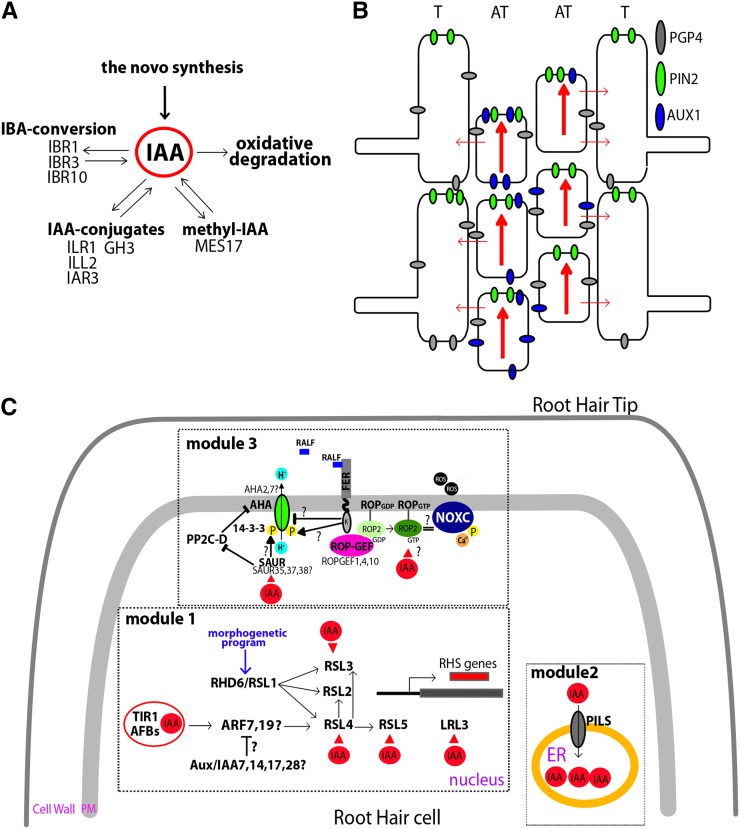Figure 1.
Auxin-mediated responses that trigger root hair growth. A, Auxin homeostasis pathways. Free indole-3-acetic acid (IAA) levels are maintained in plant cells by several mechanisms, including de novo biosynthesis and oxidative degradation. IAA-conjugate hydrolases hydrolyze IAA conjugates to free IAA. Indole-3-butyric acid (IBA) response genes (IBR1, IBR3, and IBR10) are necessary to metabolize IBA to free IAA. Methyl-IAA is converted to free IAA by MES17. B, Auxin transport in the root epidermis. PIN-FORMED2 (PIN2) and PGP4 are involved in auxin efflux in both trichoblast (T) and atrichoblast (AT) cells, whereas AUXIN RESISTANT1 (AUX1) is in charge of auxin influx located only in the atrichoblast cells. Auxin fluxes are indicated by red arrows. C, The main target of auxin in root hair cells. Auxin could trigger a transcriptional response in the nucleus via TIR/AFB-ARFs and downstream RSL/LRL3 activation of root hair-specific (RHS) genes (module 1). The morphogenetic program on root hair cells (trichoblasts) acts on RHD6/RSL1 to trigger root hair initiation growth. Auxin directly regulates the expression of several TFs, such as the central root hair regulator RSL4, as well as RSL3, RSL5, and LRL3. It is postulated, based on cell expression profile and mutant phenotypes, that ARF7 and ARF19 as well as AUX/IAA7, AUX/IAA14, AUX/IAA17, and AUX/IAA28 would be components of the auxin response in root hair cells. In addition, auxin can be regulated by its transport into and storage in the endoplasmic reticulum (ER; module 2) via PILS proteins (PILS2 and PILS5). Finally, auxin may trigger nontranscriptional responses (module 3) via plasma membrane H+-ATPases (AHA) activation affecting pH changes and FERONIA (FER)-ROP2-mediated NADPH oxidase (NOX) activation, thus increasing reactive oxygen species (ROS) production. FER could also interact with the RAPID ALKALINIZATION FACTOR1 (RALF1) peptide to trigger changes in apoplastic pH by inhibiting the H+-ATPase activity of AHA2 and suppressing cell expansion. In addition, at least for hypocotyl cells (it has not yet been validated for growing root hairs), it was demonstrated that auxin promotes the activation of AHA1 and AHA2 by the activity of SMALL AUXIN UP RNA19 (SAUR19), which interacts with and inhibits the activity of 2C protein phosphatase D1 (PP2C-D1). This phosphatase negatively regulates AHA1 activity, allowing the binding of 14-3-3 proteins to AHA1. In this model, SAUR and PP2C-D1 act antagonistically to control cell expansion (Spartz et al., 2014). It is hypothesized that SAUR35, SAUR37, and SAUR38 as well as AHA2 and AHA7, which are highly expressed in root hair cells, would be components that specifically act on this cell type. The red triangles indicate auxin activation at the transcriptional level of several TFs and SAUR proteins and, posttranscriptionally, by a still unknown mechanism to FER-ROP2.

